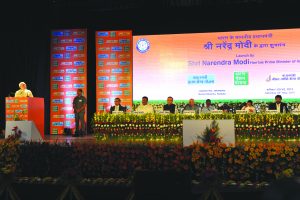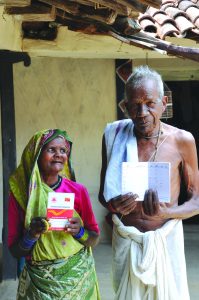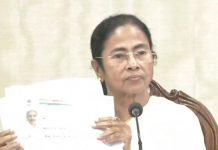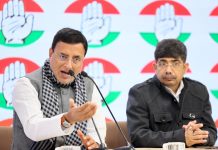 The National Social Assistance Programme (NSAP) launched by the government to provide subsistence to those who don’t have any source of income has been able to help whopping 2.84 crore eligible people in one year-2019 alone.
The National Social Assistance Programme (NSAP) launched by the government to provide subsistence to those who don’t have any source of income has been able to help whopping 2.84 crore eligible people in one year-2019 alone.
The government has released 6000 crores to states and union territories for disbursement of benefit to all the eligible beneficiaries under the NSAP as on November 30, 2019. The scheme is targeted at any such person who has little or no regular means of subsistence from his or her own source of income or financial support from family members or other sources, to be identified by states and union territories.
With the objective of providing basic level of financial support, NSAP covers a total of 2.84 crore beneficiaries. Funds amounting to 3633.30 crore (40 per cent) have also been released to the states and UTs. At present NSAP includes five sub-schemes as its components. As on November 30, 2019, an amount of 6000 crores was released to states and UTs for disbursement of benefit to all the eligible beneficiaries under schemes of NSAP. During the year 2019, 2.84 crore beneficiaries were benefitted under the schemes of NSAP. A total 13 crore Digital Transactions reported by the states and UTs under the NSAP schemes.
The data of all beneficiaries of NSAP schemes has been digitized over NSAP portal. The biometric Aadhaar authentication and Annual Life Certificate (Jivan -Praman) system, e-pramaan has been started. Social Audit is a concept that has become popular and relevant in the context of good governance. It is an important tool to empower people and ensure their participation in implementation of a scheme. Pilot on Social Audit has been successfully completed in five states and the same has been started in 10 states.
The mandate of the Ministry of Rural Development (MoRD) is sustainable and inclusive growth of rural India by increasing livelihoods opportunities, providing social safety and developing rural infrastructure. The five major rural development themes around which the current flagship Programmes of MoRD are centered are Rural Housing (through Pradhan Mantri Awaas Yojana — Gramin), Rural Employment (through Mahatma Gandhi National Rural Employment Guarantee Scheme), Rural Connectivity (through Pradhan Mantri Gram Sadak Yojana), Rural Livelihood (through Deendayal Antyodaya Yojana — National Rural Livelihoods Mission) and Rural Skilling (through Deen Dayal Upadhyaya Grameen Kaushalya Yojana and Rural Self Employment Training Institutes).
The Department is implementing programmes based on the evidence based selection of poor households as per the deprivation criteria of Socio Economic Census. The Ministry of Rural Development is implementing two welfare schemes in the field of skill development for rural poor youth under the National Rural Livelihoods Mission (NRLM) including Deen Dayal Upadhyaya Grameen Kaushal Yojana (DDU-GKY) which is a placement linked skill development program for wage employment.
Currently Deen Dayal Upadhyaya Grameen Kaushal Yojana is being implemented in 27 States and 3 Union Territories and with 641 training partners in 1624 active training centre across the country. Training is being imparted in 52 sectors covering 526 trades through 1414 ongoing projects as on date. During the current calendar year 2019, 2.29 lakhs candidates have been trained and 1.39 lakh candidates have been placed across the country.
The Deendayal Antyodaya Yojana- National Rural Livelihoods Mission aims at mobilizing about 9 crore rural poor households into Self Help Groups (SHGs) in a phased manner and provide them long-term support such that they diversify their livelihoods, improve their incomes and quality of life.
All “automatically included” households and all households with “at least one deprivation” as per the Socio Economic and Caste Census data constitute the target group of DAY-NRLM. Participatory Identification of the Poor (PIP), which is further vetted by the Gram Sabha, also validates the list of the rural poor. The major components of the scheme include promotion of sustainable institutions of the poor, ensuring access to financial services, promoting diversified livelihoods opportunities for the poor, in farm and non- farm sectors, promotion of skill development and access to jobs and promotion of social inclusion, social development and human development.
The mission has covered 5894 blocks spread over 646 districts across 29 States and 5 UTs by October 2019. More than 6.47 crore women have been mobilized into 58.7 lakh Self-Help Groups (SHGs) up to October, 2019. During the year 2019-20, up to October 2019; about 67.9 lakh women have been mobilized in to 6.55 lakh SHGs. Community driven approach is central to the Mission’s implementation strategy. By far more than 2.50 lakh Community Resource Persons have been trained on multiple interventions. During financial year 2019-20, capitalization support of nearly 743.1 crores have been provided to SHGs and its federations up to October 2019. Cumulatively, about 8334.7 crores has been provided as capitalization support under the Mission.
 The village road scheme called Pradhan Mantri Gram Sadak Yojana (PMGSY) had been launched for consolidation of 1,25,000 Km through major rural links connecting habitations, Rural Agricultural Markets etc. It is expected to sanction 15,000 Km by March 2020. Already, 36,037 Km road lengths has been constructed and 5,952 habitations have been provided connectivity so far during current year. E-marg software for maintenance of roads is being rolled out in all states.
The village road scheme called Pradhan Mantri Gram Sadak Yojana (PMGSY) had been launched for consolidation of 1,25,000 Km through major rural links connecting habitations, Rural Agricultural Markets etc. It is expected to sanction 15,000 Km by March 2020. Already, 36,037 Km road lengths has been constructed and 5,952 habitations have been provided connectivity so far during current year. E-marg software for maintenance of roads is being rolled out in all states.
Then there is a scheme to ‘pucca’ houses with basic amenities to all houseless households and households living in ‘kutcha’ and dilapidated house by 2022. The target number of houses to be constructed by the year 2021-22, to achieve the objective of “Housing for All” is 2.95 crore which is proposed to be achieved in phases. In the first phase 1.00 crore houses were taken up for construction in three years 2016-17 to 2018-19 and in the second phase 1.95 crore houses would be taken up for construction in three years 2019-20 to 2021-22.
Under the scheme unit assistance 1,20,000 is given in plain areas and 1,30,000 in hilly states and difficult areas. Out of a total of 4.04 crore households found to be eligible as 2.50 crore households have been found eligible for getting assistance. Assistance to beneficiaries is transferred electronically through the AwaasSoft-PFMS platform. This ensured seamless transfer of funds electronically into the Bank or Post Office account of each beneficiary through Fund Transfer Order (FTO). During the year 2019-20 (as on December 17, 2019), a total of 9.01 lakh FTOs amounting to 29,000.76 crores have been generated involving 79.78 lakh beneficiaries.
letters@tehelka.com













